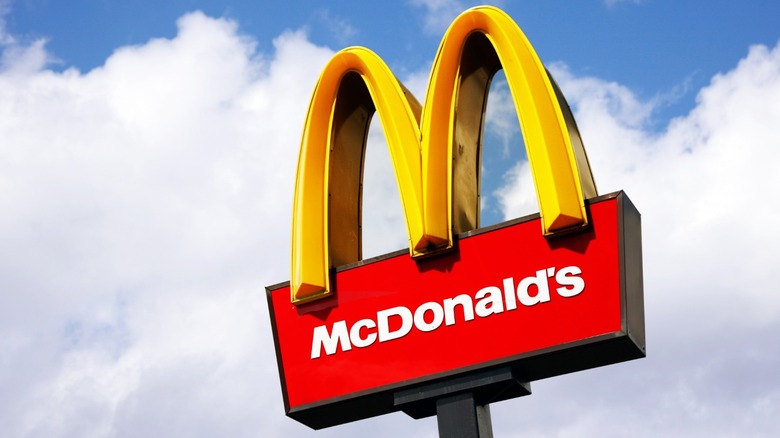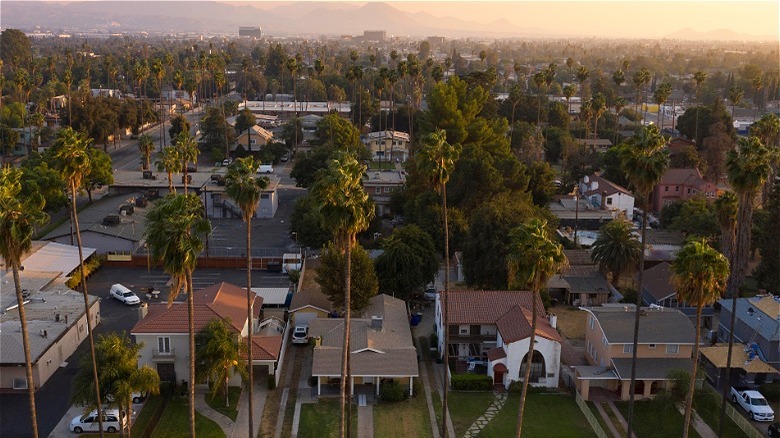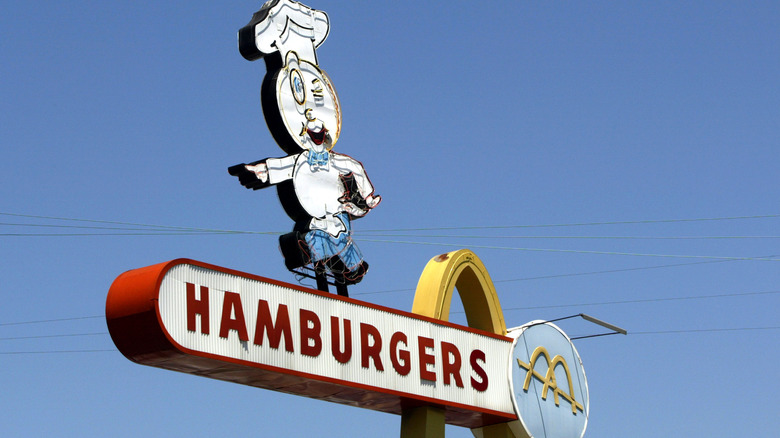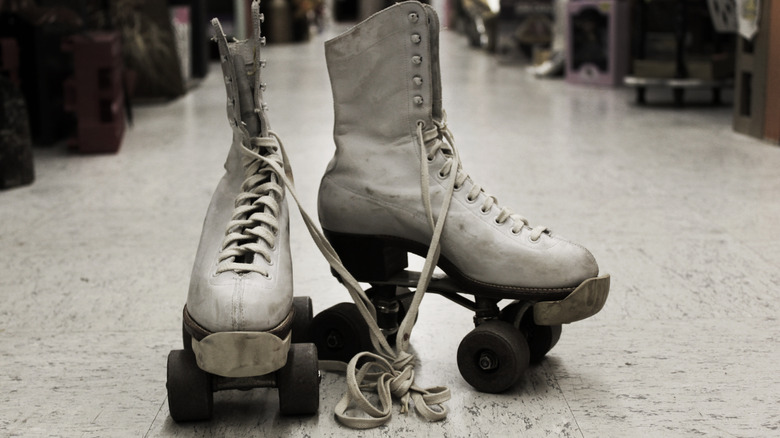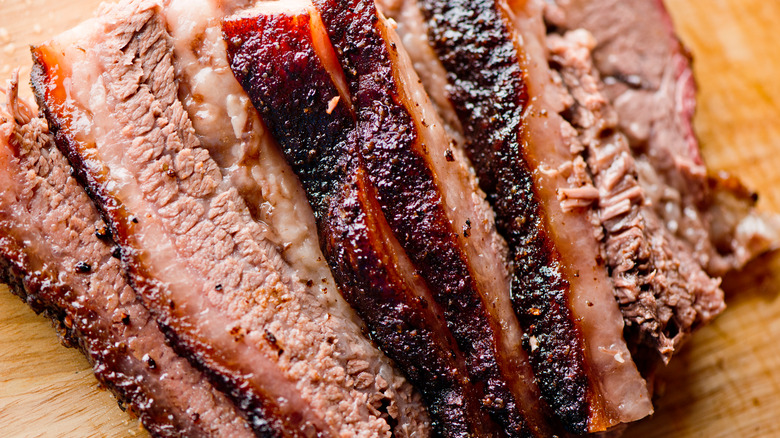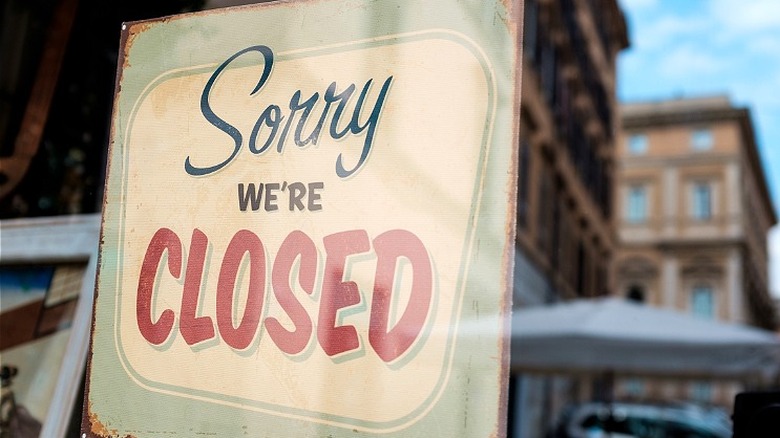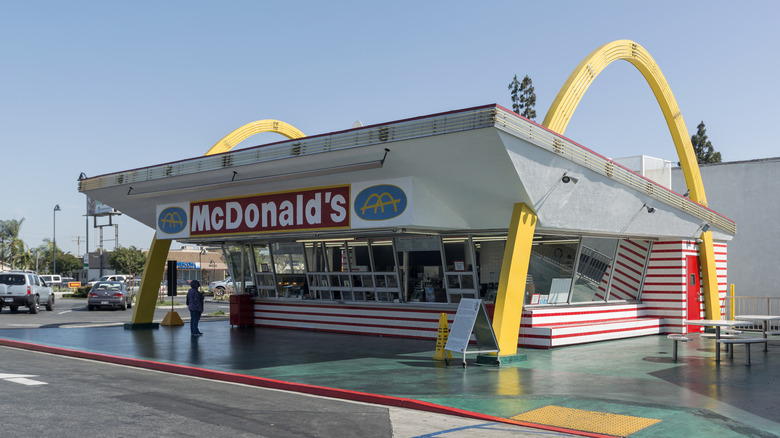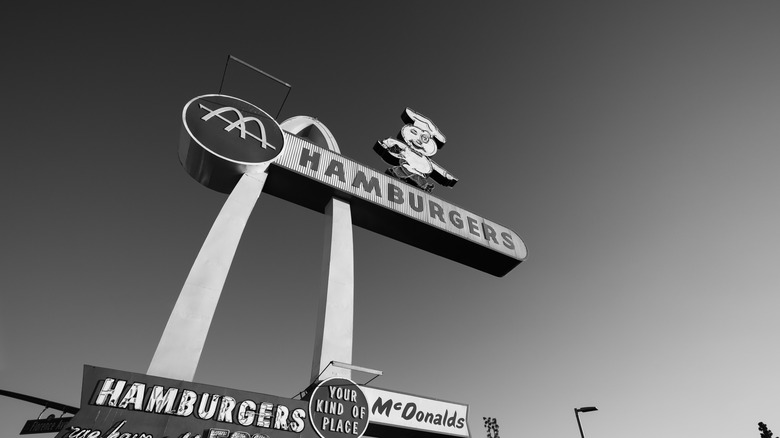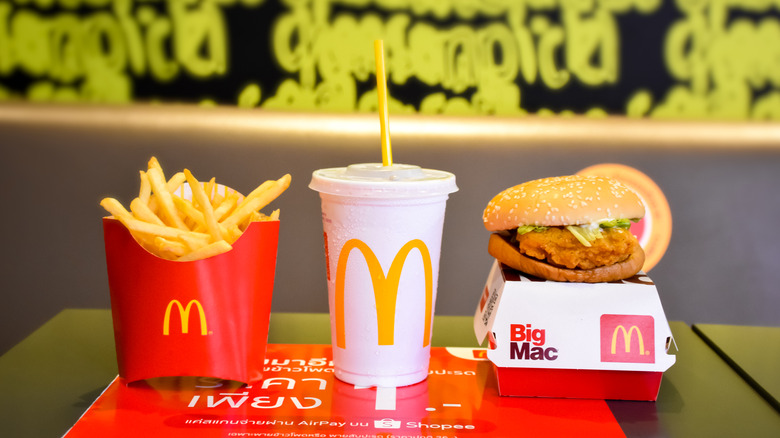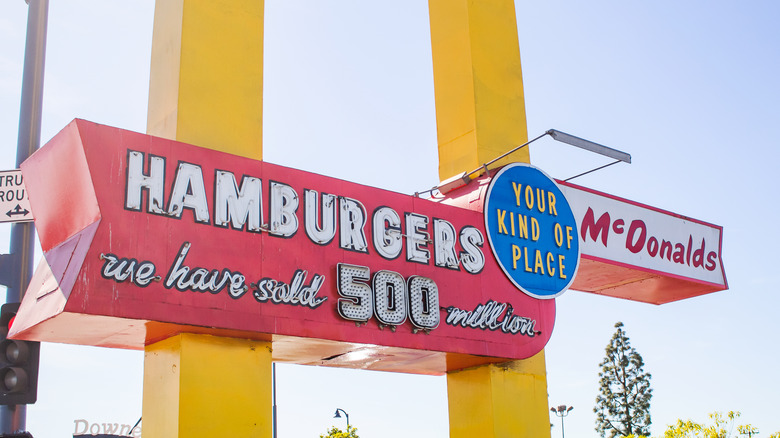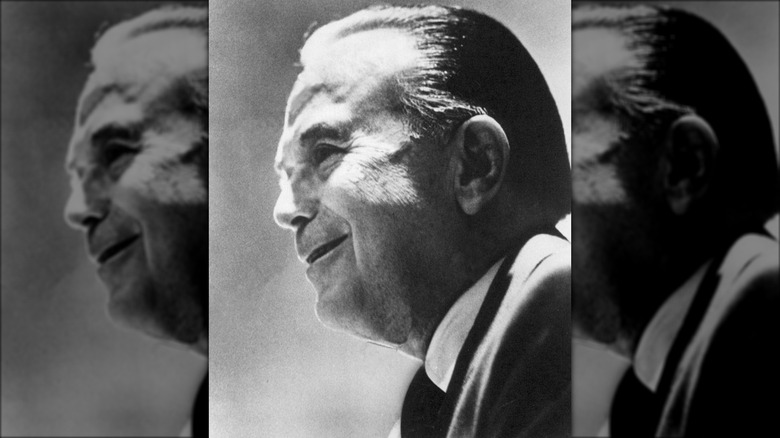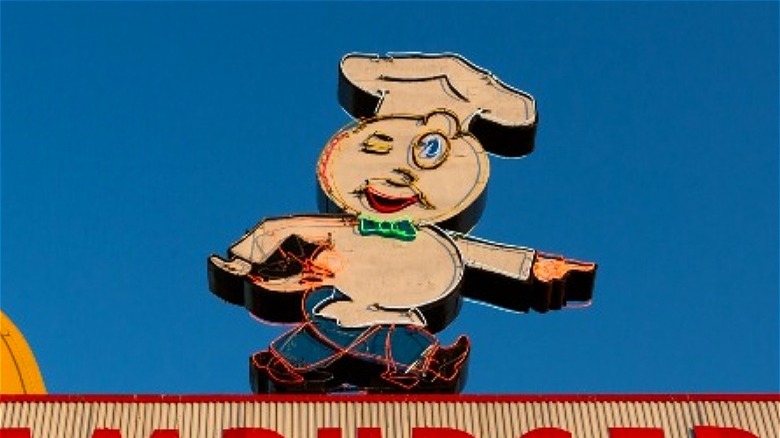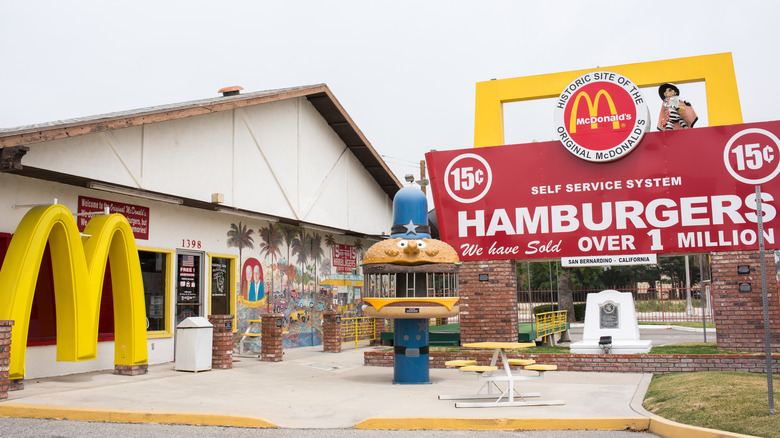What It Was Really Like To Eat At The First McDonald's
The Happy Meal, the Big Mac, and the Egg McMuffin are surely some of the most iconic McDonald's menu items. Mention them once and everyone instantly knows you're talking about McDonald's. Not only has the chain become easily recognizable — picture those golden arches now — it's everywhere you look. As of 2022, there are around 38,000 McDonald's restaurants spread across more than 100 different countries, per McDonald's. With profits increasing nearly 60% to $7.5 billion in 2021, the franchise isn't about to stop growing (via New York Times). But McDonald's is not unique. Like many a success story, the burger company came from humble beginnings.
Ray Kroc is usually referred to as the ruthless creator of this fast food company, but the chain actually didn't start with Kroc. The actual founders — whose last names were indeed McDonald — operated this California burger restaurant long before Kroc came into the picture. They did so from the first McDonald's location, which opened in the 1940s (via McDonald's).
The story of the first McDonald's restaurant is full of twists, including drastic changes to the menu, employees, and dining style. It surely didn't have the modern design, touchscreens, and celebrity-sponsored meals of today. But that's not all that was different. Read on to find out what it was really like to eat at the first McDonald's.
It was in San Bernardino, California
The first McDonald's was located in San Bernardino, California, a suburban city just east of Los Angeles (via California Through My Lens). The restaurant opened in 1940, at 1398 North East Street. The location was chosen by the founding brothers, Richard and Maurice McDonald, two New Hampshire natives who previously worked in the movie business in nearby Hollywood. Per the New England Historical Society, "Dick" and "Mac" were employed at local film studios, where they worked as handymen and set movers.
Slowly, the brothers began their transition out of Hollywood. First, they opened a movie theater in Glendora, a smaller town outside of the hustle and bustle of downtown LA (via the Los Angeles Almanac). The theater did not succeed, but they found an interest in food from managing the concessions part of the business. Next, they directed their attention to restaurants, first opening a hot dog stand in nearby Monrovia. Like their movie theater, the hot dog stand didn't take.
Finally, the McDonald boys gave up their attachment to Los Angeles and moved to San Bernardino. At the time, this city was a growing transportation hub that was larger than Monrovia or Glendora, thanks to nearby major highways like Route 66. All this meant more potential customers for the McDonald brother's restaurant. Finally, this location would prove successful for the founders.
You might have seen the founders working
If you came across Richard and Maurice, you'd meet two determined businessmen. According to the New York Times, the brothers vowed to make $1 million by the time they turned 50 years old. If you went to the first restaurant shortly after it opened in the early 1940s, you might've seen the McDonald brothers themselves working to fulfill that goal.
This drive reportedly came from their background in a working-class, Irish immigrant family, explains the New England Historical Society. During their childhood, father Patrick McDonald was suddenly fired from his decades-long job at a New Hampshire shoe factory. Per Smithsonian Magazine, the factory barely explained their dad's shocking lay-off, simply saying he was "too old."
After opening their San Bernardino restaurant in 1940, the McDonald brothers continued to make changes in how their burgeoning restaurant operated. With constant shifts underway, it's possible that some of the earliest McDonald's customers even laid eyes on Richard and Maurice as they directed their growing crew, like so many successful small business owners.
Early McDonald's carhops took your order
The earliest visitors to the first McDonald's experienced the restaurant as a drive-in establishment focused on cars. This style of drive-in restaurant was growing in popularity during the 1940s, reaching peak popularity in the 1950s (via Web Restaurant Store). With Route 66 connecting San Bernardino to the rest of the world, drivers were everywhere and so were drive-ins (via Road Trip USA).
For most of the 1940s, ordering and eating at the first McDonald's location was a typical drive-in experience (via Business Insider). Customers would arrive in their cars and park. Then, waiters would take their order, retrieve food from the kitchen, and return it to customers. During the entire experience, McDonald's diners didn't have to leave their vehicle. They simply drove in, parked, and eventually drove out.
Drive-ins were also referred to as "carhop services," named for their "carhop" waiters. The term came from the practice of waiters jumping onto a vehicle's hood to claim specific customers, as per the South Bend Tribune). Typically, carhops were expected to be female, young, and possibly wearing roller skates to speed up their work (via Restaurant-ing Through History). Many of these qualities were found among early McDonald's employees, however strange they may seem now. According to Smithsonian Magazine, the first McDonald's employed about 20 carhops.
You might have eaten barbecue
Long before the McRib was a thing, McDonald's had a passion for barbecue, which was first served at the flagship San Bernardino location (via The Street). Between 1940 and 1948, the place was even referred to as "McDonald's Bar-B-Cue Restaurant" or "McDonald's Famous Barbecue," per the Library of Congress.
According to CNN, the barbecue menu at the first McDonald's was extensive. Customers could choose from sandwiches made with barbecued pork, beef, or ham. These sandwiches cost only 35 cents each. If diners wanted something more substantial, they could order a barbecue plate, which cost 60 cents. Amusing Planet and KCET estimate the number of menu items to be between 25 and 40.
During this time, hamburgers were available, but they weren't the main event. McDonald's even sold peanut butter and jelly sandwiches, as well as tamales. Clearly, the first McDonald's hadn't found its voice yet. Yet, however strange this menu may sound today, the first location began to take off. But just as their success was growing, the founding brothers decided to shut things down.
In 1948, McDonald's might have been closed
Hungry customers who wandered into the parking lot of McDonald's Bar-B-Cue in 1948 might've been out of luck. During that year, the brothers chose to suddenly shut down their business for three months to make alterations (via McDonald's). Richard and Maurice McDonald wanted more from their business. With recent successes boosting their confidence, the brothers aspired to make their restaurant even more profitable by increasing efficiency.
The brothers took inspiration from the successful home-building company Levitt & Sons. Per U.S. History Scene, the business had recently created an entire suburb of prefabricated homes in Levittown, New York in record time. During construction, the company used assembly line-style efficiency methods to complete a new home every 16 minutes. As Smithsonian Magazine reports, the McDonald's brothers wanted to apply this strategy to burger-making.
The result was the Speedee Service System, which saw much of the McDonald's kitchen become mechanized. Condiment dispensers, burger patty makers, and milkshake-stirring machines were added to the kitchen. Meanwhile, an assembly line strategy was applied to food preparation. This method allowed 900 servings of fries to be produced per hour. As all of these changes took place, barbecue items fell by the wayside, as the McDonald's brothers found these items took too long to make.
In the early 1950s, you ordered from a walk-up window
In December 1948, after months of closure, the first McDonald's reopened. Diners from then on would encounter a very different restaurant. This new McDonald's was not only different from its previous iteration, but it stood out from competitor restaurants in the area. After its re-vamp, the kitchen wasn't the only thing about McDonald's that changed. As part of the "Speedee Service System," the founder brothers transformed the customer's experience to further increase efficiency, ditching the drive-in style that was the standard at the time, and hoping to speed up ordering methods.
Waiters no longer came to your car when taking orders or delivering food. Instead, customers had to do it themselves, by parking, getting out of their car, and walking up to a window. According to Los Angeles Magazine, the first McDonald's made the process a bit more complicated by establishing separate ordering windows for burgers, fries, and drinks. At all these windows, customers at least didn't have to wait long, thanks to the Speedee Service System's assembly line style of food preparation happening inside the kitchen. Once customers were handed a paper sack that contained their food, they could go on their way.
You may not have seen women working
Ordering wasn't the only thing visitors to the first McDonald's might've been surprised by, as the gender distribution of the staff might have genuinely shocked them. Before the Speedee Service System, most McDonald's waiters were female carhops. But when the McDonald's brothers ditched their drive-in, they fired all the women. Per Smithsonian Magazine, the founders decided to not hire any female workers back. Their reasons for doing so were interesting, to say the least.
In short, Maurice and Richard McDonald thought women were too distracting. After the revamp, they sought to remove the friendly, sometimes flirtatious atmosphere encouraged by carhops, all to speed things up. Instead, they placed more serious-looking male staffers (wearing all-white, clean uniforms) behind a window. All of it was meant to place the emphasis on fast food, rather than making time for waiters and customers to socialize.
This decision would have a lasting impact on the chain. Even as McDonald's expanded, the ban on female employees stuck. Per Jacobin, future McDonald's boss Ray Kroc maintained that women were still too distracting to be hired. The rule lasted until the mid-1960s, though eventually, the need for more employees became more pressing than the founders' sexism.
The first McDonald's menu was small
Those eating at the first McDonald's in the 1950s would've taken note of a changed menu after 1948. Gone were the days of barbecue. Instead, something more casual took center stage, making the menu look a little more like the one you see at McDonald's locations today.
With the Speedee Service System, the menu was reduced to just nine items, per McDonald's. It consisted of three beverages: milk, coffee, and soft drinks. According to History, there were only three different soda flavors and all fountain drinks came in 12-ounce servings. For food, hamburgers and cheeseburgers took center stage, while potato chips were the exclusive side. For dessert, there was just pie. Just one year later, in 1949, McDonald's eliminated potato chips from the menu, replacing them with french fries. That same year, milkshakes — called "Triple Thick Milkshakes" — joined the lineup.
The downsized menu was much more efficient, as fewer and simpler items meant less time spent preparing and cooking food. The limited menu also sped things up for customers, who no longer had to choose from dozens of items.
The whole meal cost less than a dollar
Patrons at the first McDonald's would not have just encountered a small menu, but an affordable one even by the standards of the times. After eliminating barbecue, after all, the founders discovered that meals were cheaper to make. Moreover, employees could produce hamburgers and fries faster than a plate full of barbecued meats. All told, those cheaper ingredients, plus the ability to sell more meals per hour, allowed the first McDonald's to lower its menu prices. Per KCET, after 1948, the restaurant became widely known for its economical meals.
As Huffington Post explains, during the 1950s, each of the nine menu items cost less than a quarter. Cheeseburgers cost 19 cents. Fries cost 10 cents. All beverages, which included coffee, milk, and fountain drinks, were just a dime apiece. The most expensive item was a milkshake, priced at 20 cents. As McDonald's explains today, the staple item was the 15-cent hamburger. You could get an entire meal (a burger, fries, and shake) for just 45 cents. With one dollar, you could feed two people, making McDonald's a serious competitor in the growing world of fast food.
Ray Kroc sold the restaurant its milkshake machines
He may not have founded it, but Ray Kroc did visit the first McDonald's as a salesman, according to TIME. Long before he became McDonald's millionaire CEO, Kroc sold various supplies to fast food companies such as Dairy Queen. First, he sold paper cups, though he later upgraded to milkshake machines. This brought him into the orbit of Maurice and Richard McDonald when Kroc sold the founding brothers several of these machines, known as "multi-mixers."
As the name implies, these multi-mixers allowed the first McDonald's to make multiple milkshakes at once. Given how much business boomed following the restaurant's overhaul in 1948, they needed to make a lot. Indeed, Kroc found the number of milkshakes being made shocking. After selling the brothers eight multi-mixers, Kroc told the New York Times that he simply had to see what kind of place needed to prepare 40 milkshakes simultaneously. So, Kroc visited the first McDonald's location in 1954 (via McDonald's). This visit would have a lasting impact, but McDonald's customers in the early 1950s would not have known about this. Instead, they likely would only have noticed the speed with which their milkshake was prepared compared to other restaurants.
Ronald McDonald was not the first mascot
Though he's everywhere these days, those eating at the first McDonald's would not have seen Ronald McDonald. Instead of a smiling clown, they would have encountered "Speedee," a character named after the efficiency system launched in 1948. As RetroPlanet explains, Speedee was meant to visually communicate just how fast McDonald's food could make it to a customer. The mascot wore a white uniform, not much different than the employees of the first McDonald's, and had a burger-shaped head.
At the first McDonald's, you'd see a simple version of the chain's founding mascot, but in later iterations, Speedee was given a little more energy. Sometimes, Speedee's legs were shown moving rapidly using a succession of neon lights. In other cases, he pointed to the restaurant or held a sign reading "I'm Here," per RetroPlanet. This represented Speedee's ability to spring into action, implying that McDonald's itself would do this for customers.
Speedee would be replaced in the early 1960s, per Britannica. His successor, a colorful clown deemed Ronald McDonald, was meant to market the chain to children. Yet, after decades of Ronald McDonald doing just that, McDonald's began to face backlash for the mascot. According to MarketingWeek, people disliked that the character encouraged children to eat the unhealthy foods on McDonald's menus.
There were no golden arches
If you're trying to picture the first McDonald's in its heyday, you can start by removing those golden arches. That's because, in the very beginning, there weren't the large, yellow arches you see in McDonald's restaurants today. But the rise of the now-iconic logo shows how the McDonald brothers had a bigger role in the chain than many know.
According to the BBC, the founding McDonald brothers workshopped the design in the early 1950s. While their San Bernardino location was taking off, the brothers thought of opening another restaurant. They met with Los Angeles architects Stanley Clark Meston and Charles Fish and, together, they worked to come up with a design that could lure drivers to a roadside restaurant. In the end, they decided on two giant, yellow half-circles attached to both sides of the building. The structures were lit with neon, making them visible at any time of day or night.
In 1953, the first building to sport the golden arches opened in Phoenix, Arizona (via AZCentral). The restaurant was also the second McDonald's ever, as well as the first franchise location. However, the arches wouldn't form the "M” shape of the McDonald's logo that is so familiar now. Per LogoMyWay, the beginnings of that idea would first take shape under Ray Kroc's leadership in the 1960s.
Some believed it was the second McDonald's
To understand what it was like at the first McDonald's, we've got to weed out the misgivings about the beginnings of this chain. In several corners of the internet, you'll find people referring to a Des Plaines, Illinois location as the "first" McDonald's, even kind of by McDonald's itself.
This restaurant is not at all the founding spot, but simply the first location opened by Ray Kroc instead of founders Richard and Maurice McDonald. The Des Plaines location of McDonald's opened on April 15, 1955. That's 15 years after the real first McDonald's opened in San Bernardino, California. It's also two years after the first franchise location opened in Phoenix, Arizona (via AZCentral).
This midwestern location at least has some close ties to the first McDonald's. Only one year after visiting the McDonald's San Bernardino restaurant for the first time in 1954, Kroc opened the Des Plaines, Illinois location (via McDonald's). But don't get it twisted: the Illinois spot wasn't the first franchise location, the first McDonald's, nor the first to sport the golden arches. It was simply one of the first steps Kroc took in his effort to take over from founding brothers Maurice and Richard McDonald.
